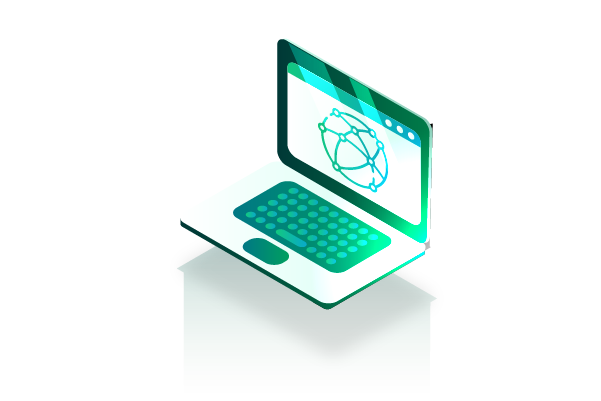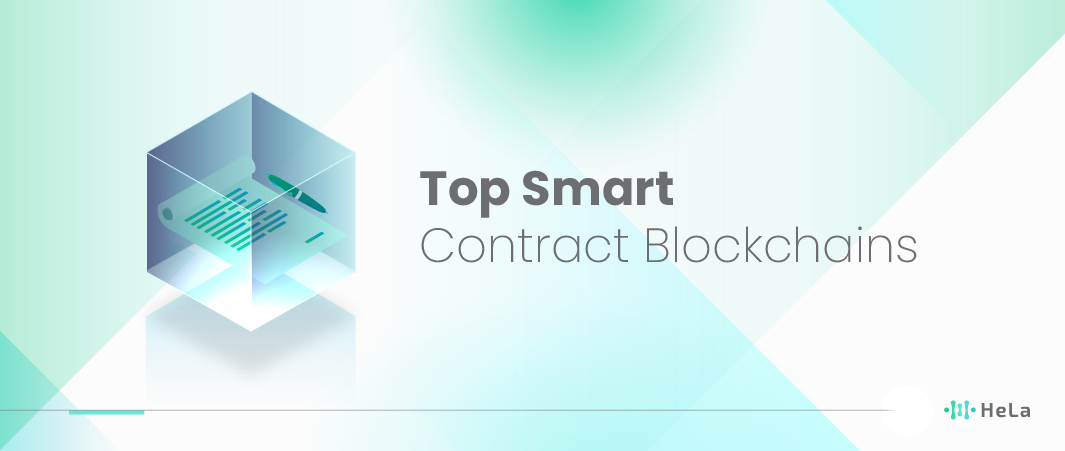Layer-1 and Layer-2 solutions are shaping the future of blockchain adoption, catering to developers who need efficiency without compromising decentralization. Whether you’re a developer looking for the best platform to build on, an investor seeking promising blockchain ecosystems, or a business exploring Web3 integration, understanding the leading smart contract blockchains is essential. In this article, we highlight the top 10 smart contract blockchains to know in 2025, breaking down their key features, innovations, and why they stand out in the ever-evolving crypto landscape.
Choosing the right smart contract blockchain can be daunting given the plethora of options available. Each platform comes with its own set of advantages, challenges, and use cases. This guide aims to simplify this choice by highlighting the top smart contract blockchains in 2025, taking into account their performance, community support, ease of use, and real-world applications. Whether you’re a developer, an entrepreneur, or simply a blockchain enthusiast, understanding these platforms is crucial for navigating the future of digital contracts.
Understanding Smart Contract Security

Understanding smart contract security involves a deep dive into the intricacies of blockchain technology and the coding practices involved in creating smart contracts. Smart contracts are self-executing contracts with the terms of the agreement between buyer and seller being directly written into lines of code. These contracts run on blockchain networks, which ensure transparency, security, and immutability. However, the very features that make smart contracts innovative also expose them to unique security risks. Here’s a more detailed exploration:
Common Security Challenges
- Reentrancy Attacks: This occurs when a malicious contract calls back into the calling contract before the first execution is completed, potentially draining funds. The infamous DAO attack is a prime example of a reentrancy attack.
- Arithmetic Overflows and Underflows: Smart contracts often perform arithmetic operations. Without proper validation, operations can overflow (exceed maximum value) or underflow (drop below zero), leading to unintended behaviors.
- Gas Limitations and Loops: Contracts with loops or operations that consume a high amount of gas can hit the block gas limit, causing transactions to fail. This can be exploited to make certain functionalities unavailable.
- Timestamp Dependence: Using block timestamps for critical contract logic can be risky since miners have some influence over it, potentially allowing manipulation.
- Randomness in Blockchain: Generating true randomness in a deterministic system like a blockchain is challenging. Dependence on pseudo-randomness can be exploited by attackers.
- Short Address Attack and Signature Issues: These involve manipulating the way blockchain handles addresses or signatures, potentially redirecting transactions or compromising contract integrity.
Also Read: Mainnet Vs. Testnet: A Comprehensive Comparison
Mitigation Measures
To address these challenges, several strategies and best practices have been developed:
- Smart Contract Audits: Before deployment, contracts undergo rigorous audits by independent third parties to identify vulnerabilities.
- Using Established Libraries and Patterns: Leveraging well-tested libraries and design patterns, like OpenZeppelin for Ethereum, can reduce the risk of common vulnerabilities.
- Secure Development Practices: Adopting secure coding practices, thorough testing, and continuous monitoring can mitigate risks. This includes using languages designed for smart contract development, such as Solidity for Ethereum, which are constantly updated to address security issues.
- Bug Bounties and Continuous Monitoring: Offering rewards for discovering vulnerabilities and continuously monitoring contract activity can help identify and mitigate issues quickly.
- Upgradeability: Implementing mechanisms that allow for smart contract upgrades can help fix vulnerabilities as they are discovered, though this introduces additional layers of complexity and potential risks.
- Decentralized Security Tools and Services: Utilizing decentralized applications (DApps) that specialize in security, such as those providing real-time monitoring and automatic vulnerability detection, can enhance smart contract security.
- Educating Developers and Users: Providing comprehensive resources and training for both smart contract developers and users about security best practices is essential for fostering a secure blockchain ecosystem.
While smart contracts offer a revolutionary way to automate and enforce agreements without intermediaries, their security is of utmost concern. The combination of understanding common vulnerabilities, employing mitigation strategies, and fostering a culture of security-first development is critical for safeguarding the integrity and value of smart contracts on any blockchain platform.
10 Top Smart Contract Blockchains in 2025

Smart contract blockchains are platforms that enable the creation and execution of self-executing contracts with the terms of the agreement directly written into code. These contracts automatically execute when predefined conditions are met, without the need for intermediaries. Here are 10 top smart contract blockchains, each with its unique features and capabilities:
1. HeLa
HeLa is a pioneering Layer-1 blockchain platform engineered for seamless real-world integration. It stands out through its strategic partnership with A*STAR’s Institute of High-Performance Computing (IHPC), showcasing a commitment to cutting-edge technological development.
Hela boasts Ethereum Virtual Machine (EVM) compatibility, ensuring a smooth transition for developers from Ethereum-based projects. Its architecture is meticulously designed to be modular, enhancing both flexibility and scalability to meet diverse application needs. Security is a cornerstone, with robust mechanisms in place to safeguard transactions and interactions.
A notable innovation is its Decentralized Digital Identity (DID) system, which enhances user privacy while ensuring asset integrity. Hela’s use of a stablecoin for transaction fees represents a thoughtful approach to maintaining low and predictable costs. The platform is committed to fostering an open and inclusive ecosystem, making it accessible to builders across the spectrum, from nascent startups to established enterprises.
2. Ethereum
Ethereum is the trailblazer of smart contract technology, maintaining its position at the forefront of the blockchain domain through its transition to Ethereum 2.0. This evolution marks a significant shift towards scalability and energy efficiency, addressing some of the critical challenges faced by the network.
Ethereum 2.0 introduces proof-of-stake (PoS), reducing the network’s carbon footprint while increasing transaction throughput. It remains the most expansive ecosystem for decentralized applications (dApps), offering unparalleled developer support and community engagement. Ethereum’s influence extends across numerous sectors, including finance, art, and governance, continually pushing the boundaries of what blockchain technology can achieve.
3. Polkadot
Polkadot introduces a revolutionary interoperability solution with its parachain architecture. This design enables multiple, diverse blockchains to operate seamlessly together, fostering a level of collaboration and evolution previously unattainable.
Polkadot’s governance model is designed to facilitate upgrades and changes without resorting to hard forks, ensuring a stable and progressive development environment. The platform’s interoperability extends beyond simple asset transfers, allowing for a wide range of data and functionality to be shared across chains. This makes Polkadot a central figure in the creation of a truly interconnected blockchain ecosystem.
4. Binance Smart Chain (BSC)
Binance Smart Chain (BSC) is celebrated for its high throughput and EVM compatibility, making it a magnet for decentralized finance (DeFi) projects and decentralized applications (dApps).
Its dual-chain architecture allows users to get the best of both worlds: the robust capabilities of Binance Chain for fast trading and the flexible programmability of BSC for smart contracts. BSC achieves scalability through a consensus model that balances speed and decentralization, and its attractive transaction fee structure further enhances its appeal to developers and users alike.
5. Cardano
Cardano distinguishes itself with a foundation built on scientific philosophy and peer-reviewed academic research. Its development is characterized by a methodical, phased approach, gradually introducing advanced features like smart contracts and decentralized finance capabilities.
Cardano’s Ouroboros proof-of-stake algorithm is a testament to its commitment to energy efficiency and scalability. The platform’s rigorous approach to security and sustainability positions it as a formidable contender for supporting global financial systems and beyond, aiming to provide equitable access to technology across the world.
6. Solana
Solana is renowned for its high-speed blockchain infrastructure, capable of processing tens of thousands of transactions per second thanks to its innovative proof-of-history (PoH) and proof-of-stake (PoS) consensus mechanisms.
This efficiency has catapulted Solana to the forefront of blockchain platforms suited for high-frequency trading, gaming, and decentralized finance applications. The network’s capacity for rapid transaction processing, coupled with low fees, makes it an attractive platform for developers and users seeking performance without compromise.
7. Avalanche
Avalanche stands out for its unique approach to scalability and rapid transaction finality. It allows for the creation of customized blockchains and subnets, catering to a wide array of use cases from DeFi applications to enterprise-level solutions.
Its consensus mechanism is designed to achieve high throughput without sacrificing decentralization or security. Avalanche’s ecosystem is growing rapidly, with a focus on user-friendly applications, financial products, and services that push the boundaries of blockchain technology.
8. Tezos
Tezos features a self-amending cryptographic ledger, enabling the blockchain to upgrade itself through an on-chain governance process without the need for hard forks. This innovative approach ensures that Tezos can continuously evolve in response to the needs of its community and emerging technological advancements.
It also places a strong emphasis on formal verification of smart contracts, which significantly enhances the security and reliability of the network. Tezos is aimed at facilitating a more democratic and participatory ecosystem, where stakeholders have a real say in the direction of the platform’s development.
9. Algorand
Algorand positions itself as a cornerstone in the realm of finance and decentralized finance (DeFi), offering both scalability and a developer-friendly environment. Its unique consensus algorithm, Pure Proof-of-Stake (PPoS), ensures full participation, protection, and speed within a truly decentralized network.
Algorand’s smart contracts are written in TEAL, a language designed for simplicity and efficiency. The platform is committed to removing the technical barriers that have hindered blockchain adoption, aiming to foster a wide range of applications from financial services to public utilities.
10. Cosmos
Cosmos is acknowledged for its pioneering approach to scalability and interoperability in the blockchain space. It is a decentralized network of independent parallel blockchains, each powered by BFT consensus algorithms like Tendermint. Cosmos’ vision is to create an “Internet of Blockchains,” where various blockchains can communicate and transact with each other seamlessly.
This interoperability is facilitated by the Inter-Blockchain Communication (IBC) protocol, enabling the exchange of data and assets across sovereign, decentralized blockchains. Cosmos stands as a testament to the collaborative future of blockchain networks, offering tools and protocols that empower developers to build innovative and interoperable applications.
The Role of Smart Contracts in Decentralized Finance (DeFi)
Smart contracts play a pivotal role in the evolution and functionality of Decentralized Finance (DeFi), a sector within the blockchain industry that aims to recreate and improve upon traditional financial systems without the need for centralized intermediaries. These self-executing contracts with the terms of the agreement directly written into lines of code have become the backbone of DeFi applications, offering a wide range of financial services on blockchain networks.
- Enabling Trustless Transactions: Smart contracts are integral to DeFi because they enable trustless transactions. This means that parties can engage in financial agreements without needing a trusted third party, such as a bank or a lawyer, to oversee the transaction. The smart contract automatically executes the transaction once predefined conditions are met, reducing the potential for fraud and eliminating the need for intermediaries.
- Lending and Borrowing Platforms: One of the most popular applications of smart contracts in DeFi is in lending and borrowing platforms. These platforms use smart contracts to manage the entire lending process, from the creation of debt agreements to the distribution of interest payments. This has dramatically lowered the barriers to entry for lending and borrowing, allowing users to access these services directly from their wallets without going through traditional financial institutions.
- Stablecoins: Smart contracts also facilitate the creation and management of stablecoins, which are cryptocurrencies pegged to the value of stable assets like the US dollar. These digital currencies rely on smart contracts to maintain their peg, either through collateralization with other cryptocurrencies or through algorithms that manage supply and demand. Stablecoins are crucial for DeFi, providing a stable medium of exchange and a safe haven during volatile market conditions.
- Tokenized Assets: Furthermore, smart contracts enable the tokenization of real-world assets, allowing them to be bought, sold, and traded on the blockchain. This includes everything from real estate to artwork, expanding the possibilities for investment and ownership. Through smart contracts, these assets can be divided into smaller, more affordable shares, making investment opportunities more accessible to a broader audience.
- Automated Market Makers (AMMs): Smart contracts are also the foundation of Automated Market Makers, a type of decentralized exchange that allows for the trading of digital assets without the need for an order book. AMMs use liquidity pools and algorithms to determine the price of assets, enabling seamless and instant trading.
- Governance: In many DeFi projects, smart contracts are used to facilitate decentralized governance, allowing token holders to vote on changes to the protocol. This democratizes decision-making and ensures that changes to the platform are in the best interest of its users.
Smart contracts are central to the operation and success of DeFi, providing the framework for a wide array of financial services that are more accessible, efficient, and transparent. Their ability to automate complex processes, ensure security and trust, and create new forms of financial instruments is what makes DeFi a revolutionary force in the financial world.
The Future of Smart Contracts and Blockchain Technology

The future of smart contracts and blockchain technology appears to be on a promising trajectory, driven by continuous advancements and growing interest from a wide range of industries. As we look ahead, several key developments are expected to shape the evolution of smart contracts, making them more versatile, secure, and accessible to a broader audience.
Increased Adoption in Traditional Industries
Smart contracts are poised for increased adoption in traditional sectors such as finance, real estate, healthcare, and supply chain management. Their ability to automate transactions and enforce agreements transparently and securely without the need for intermediaries makes them highly attractive.
For instance, in the financial sector, smart contracts can streamline processes like loans, insurance claims, and payments, reducing the time and cost associated with these transactions. In real estate, they can simplify the buying and selling process by automating property transfers and reducing fraud. As industries recognize the efficiency and security benefits of smart contracts, their integration into traditional business operations is expected to accelerate.
Advancements in Cross-Chain Functionality
One of the limitations of current blockchain platforms is the lack of interoperability between different chains, which can hinder the seamless exchange of information and value. However, advancements in cross-chain technology are set to overcome these barriers, enabling smart contracts to interact across various blockchain networks.
This will facilitate the creation of more complex and functional decentralized applications (dApps) that can leverage the strengths of multiple blockchains, such as combining Ethereum’s smart contract capabilities with Bitcoin’s robust security. Cross-chain functionality will not only enhance the scalability and efficiency of smart contracts but also expand their potential use cases across different ecosystems.
Integration of Artificial Intelligence
The integration of artificial intelligence (AI) with smart contracts represents a frontier for innovation in blockchain technology. AI can augment smart contracts by providing advanced decision-making capabilities, predictive analytics, and automated management of complex datasets.
For example, AI can enable smart contracts to automatically adjust terms based on changing market conditions or to execute trades with optimal timing in financial markets. Additionally, AI can enhance the security of smart contracts by identifying and mitigating potential vulnerabilities or fraudulent activities. The synergy between AI and smart contracts could unlock new levels of automation, efficiency, and intelligence in various applications.
Legal and Regulatory Considerations for Smart Contracts

Legal and regulatory considerations are pivotal for the broader acceptance and implementation of smart contracts within various sectors. As smart contracts operate on blockchain technology, understanding the regulatory environment that governs these technologies is essential for developers, businesses, and legal practitioners. This section delves into the current legal framework, challenges, and key considerations surrounding smart contracts and blockchain technology, aiming to provide a comprehensive overview for stakeholders involved in their development and deployment.
Understanding Smart Contracts and Blockchain Regulation
Smart contracts are self-executing contracts with the terms of the agreement directly written into lines of code. The blockchain provides a decentralized platform for these contracts to operate, ensuring transparency, security, and immutability. However, the decentralized nature of blockchain poses unique challenges for regulatory oversight, making it crucial for stakeholders to navigate the legal landscape carefully.
- Jurisdictional Challenges: One of the primary legal challenges surrounding smart contracts is the issue of jurisdiction. Since blockchain operates on a global network, determining which country’s laws apply to a contract can be complex. This complexity requires developers and businesses to consider the legal implications of cross-border transactions and to ensure that their smart contracts comply with the laws of all relevant jurisdictions.
Also Read: 5 Ways To Recover Funds From Cryptocurrency Scam
- Contractual Legality and Enforceability: Another key consideration is the legal status and enforceability of smart contracts. While smart contracts can automate transactions and enforce terms without human intervention, questions remain regarding their recognition as legally binding contracts under existing contract law in various jurisdictions. Stakeholders must ensure that smart contracts meet all the legal requirements of a traditional contract, including offer, acceptance, consideration, and the intention to create legal relations.
- Regulatory Compliance: Regulatory compliance is also a significant concern, especially in sectors such as finance, healthcare, and real estate, where strict regulations govern transactions. Smart contract developers and users must ensure that their applications comply with existing laws and regulations, including those related to consumer protection, privacy, anti-money laundering (AML), and know your customer (KYC) requirements.
Navigating Legal Uncertainties
Given the nascent stage of blockchain technology and the evolving legal framework, stakeholders must stay informed about legal developments and regulatory guidance affecting smart contracts. Engaging with legal professionals who specialize in blockchain and smart contract law can provide valuable insights and help navigate these complexities. Additionally, participating in industry groups and forums can offer opportunities to influence policy discussions and contribute to the development of legal standards for smart contracts.
Conclusion
The landscape of smart contract blockchains in 2025 is diverse and promising, offering a range of solutions tailored to different needs and applications. From Ethereum’s continued dominance to the rise of fast, efficient platforms like Solana and Avalanche, the choices for developers and businesses are abundant. As these technologies mature, the emphasis on security, scalability, and user experience will become increasingly important, guiding the future direction of smart contract development.
The integration of smart contracts into various industries signifies a shift towards more transparent, efficient, and trustless systems. However, challenges such as security vulnerabilities and regulatory uncertainty remain. Addressing these issues head-on, through continuous innovation and dialogue with regulatory bodies, will be crucial for the widespread adoption of smart contract technology.
As we look to the future, the potential of smart contracts to revolutionize industries beyond finance is immense. From healthcare to real estate, the ability to execute agreements automatically, securely, and efficiently will unlock new possibilities for efficiency and innovation. The journey of smart contract blockchains is just beginning, and staying informed about these platforms is essential for anyone looking to be part of the next wave of digital transformation.
Disclaimer: The information provided by HeLa Labs in this article is intended for general informational purposes and does not reflect the company’s opinion. It is not intended as investment advice or recommendations. Readers are strongly advised to conduct their own through research and consult with a qualified financial advisor before making any financial decisions.

Joshua Soriano
I am Joshua Soriano, a passionate writer and devoted layer 1 and crypto enthusiast. Armed with a profound grasp of cryptocurrencies, blockchain technology, and layer 1 solutions, I've carved a niche for myself in the crypto community.
- Joshua Soriano#molongui-disabled-link
- Joshua Soriano#molongui-disabled-link
- Joshua Soriano#molongui-disabled-link
- Joshua Soriano#molongui-disabled-link

